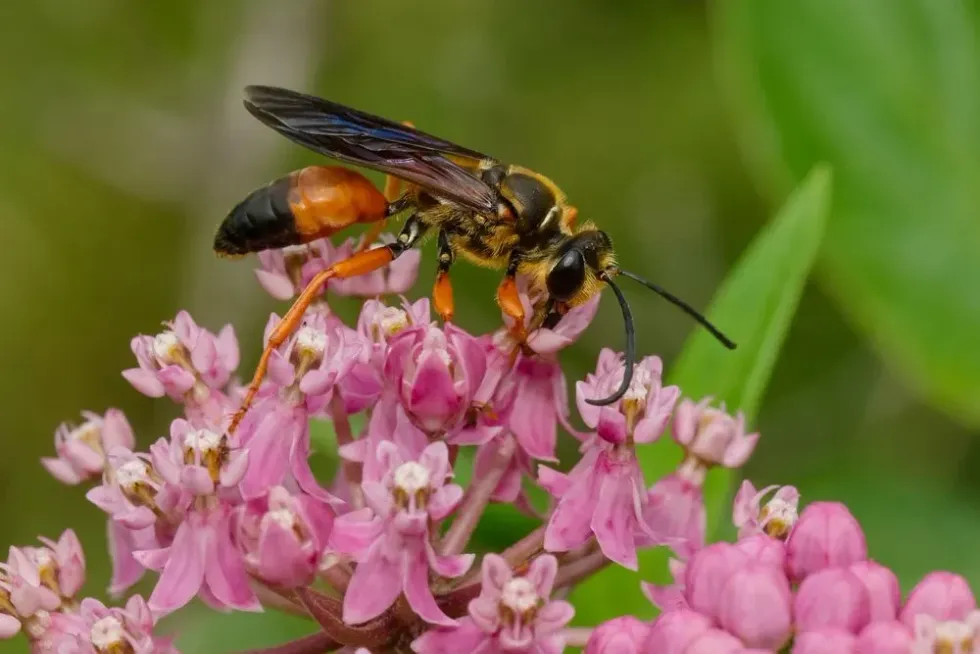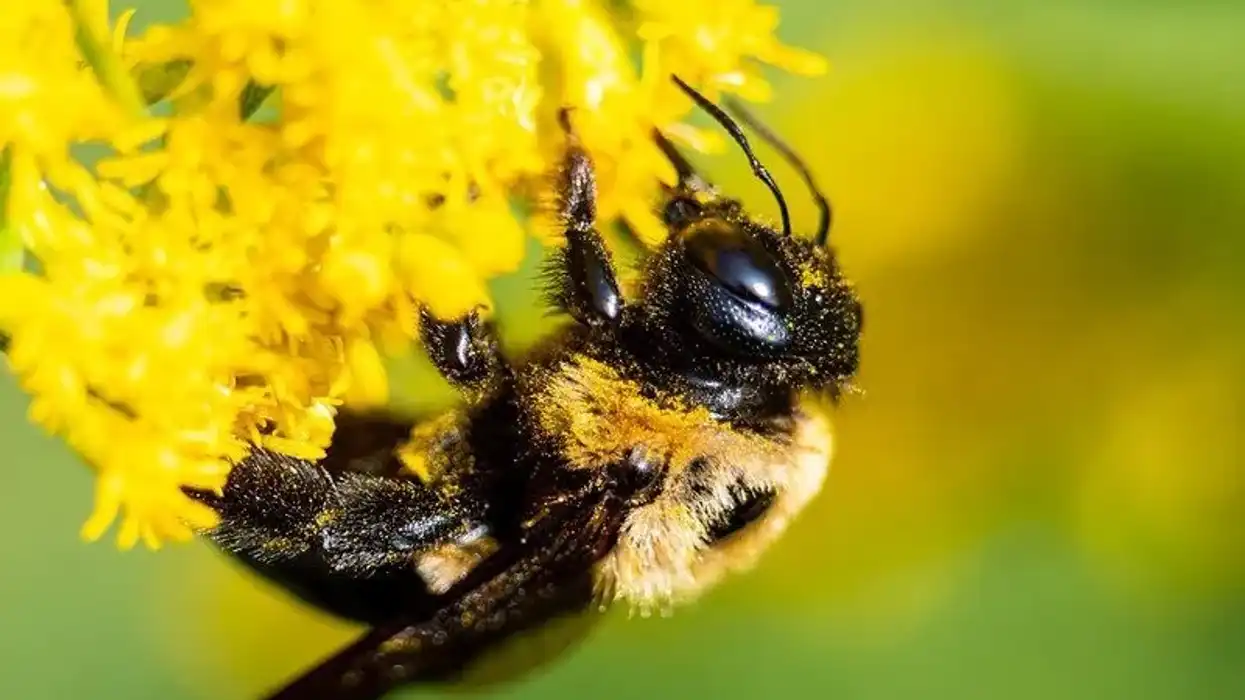Sphex ichneumoneus is commonly known as great golden digger wasps or great golden sand digger wasps. The great golden digger wasp (sphex ichneumoneus) is identified by the golden pubescence on its head and thorax along with reddish-orange legs and a partly reddish-orange body.
Their black head and thorax are covered with short golden hair, hence its name has gold in it. These solitary wasps are normally 1 in long and very rarely will you find a wasp with a length of 2 in or more.
Their scientific name, Sphex Ichneumoneus, means tracker in Greek, this is apt for them as they are known to track their prey. They have large amber wings that make a rustling sound when they fly.
The species in this genus are giant cicada killer wasps.
They are found in the North, Central, and South American regions. The adults eat sap fluids and a variety of flower nectar as they fly over them in gardens, parks, fields, and meadows.
It is not easy to observe their behavior pattern or overall lifestyle. They do not linger around flowers, and they are very scared of anything bigger than them.
They prefer to be left alone and are not aggressive as long as they are not handled. These wasps prefer staying by themselves and do not share their duty of nest-making or caring for their young ones with anyone.
The great golden digger wasp is observed to not focus on its surroundings but just on the task at hand. It doesn't change its behavior pattern, which is genetic, for any reason.
If the great golden sand digger is found in large concentrations, they are vulnerable to an attack by birds of prey as it will be an easy and large source of food for them.
No other digger wasps are attacked by birds in this way. After reading about these wasps, you may also look at black carpenter ant facts and great black wasp facts.
Great Golden Digger Wasp Interesting Facts
What type of animal is a Great Golden Digger Wasp?
The great golden digger wasp is a type of insect found in North, Central, and South America during the summer months, especially around gardens, parks, and meadows. Diggers are also known as mud daubers. These wasps are solitary insects from the family Sphecidae.
What class of animal does a Great Golden Digger Wasp belong to?
The great golden digger wasp belongs to the Insecta class of animals and the wasp family. They are a type of wasp which are not aggressive and have genetically defined behavior patterns that they follow all the time.
How many Great Golden Digger Wasps are there in the world?
The exact number of great golden digger wasps is difficult to find as there are still studies ongoing about these creatures' behavior patterns. However, this species of digger wasps are not endangered as they are found in their habitat easily during the summer months.
However, humans using insecticides or pesticides on them may cause their population to decline or affect them severely.
Where does a Great Golden Digger Wasp live?
The great golden digger wasp insect is found in open spaces during the summer months. These solitary wasps are found in southern Canada, the United States of America, Mexico, Brazil, Peru, and Ecuador.
What is a Great Golden Digger Wasp's habitat?
The great golden digger wasp is found in open grounds, gardens, parks, fields, meadows, farmlands, and other regions with flowers and smaller creatures to prey on. Their nests are also in the open, exposed to the sun.
Who do Great Golden Digger Wasps live with?
These wasps prefer staying by themselves and do not share their duty of nest-making or caring for their young ones with anyone. Females are solitary and do not like being disturbed in the garden.
How long does a Great Golden Digger Wasp live?
The great golden digger wasp lives for one or two months as an adult. The females will dig long vertical holes in the sandy grounds which are connected to the short side tunnels for nesting.
There will be up to six such nests during the summer months. The young ones spend their time in these burrows during the winter and emerge from them as adults the next year.
How do they reproduce?
The great golden digger wasp female does most of the work of nest-building and taking care of the young ones by itself. Females will start preparing for egg-laying by digging a set of holes that are interconnected.
She will dig at least six such vertical burrows. The female great golden digger wasp will never digress from this work and perform the tasks most methodically and concisely.
There is not much vegetation around their nest, and they lie out in the open without any cover.
She will use her mandibles to cut the earth vertically by taking steps at least one inch backward from the nesting site with the dug soil between her forelegs and head. Then females flip the soil with their forelegs beneath their body, scattering it to the sides using their hind legs.
She constructs a cylinder-shaped tunnel with a half-inch diameter and four to six inches deep. This becomes her main tunnel from which she will dig secondary tunnels for each larvae cell.
These cells are parallel to the earth and broader than the main tunnel. She will then close the opening of these tunnels temporarily by using the soil she dug out.
She will now fly towards the open fields of the garden to hunt for small orthopterans like crickets, katydids, and grasshoppers.
These are the food source for her eggs and larvae. After capturing them she will paralyze them with the toxins in her sting and fly towards her nest.
She will fly with smaller prey and walk with larger ones. Once near the nesting site, she will drop the prey beside it and go down into the burrows to inspect them.
When she is satisfied, she will come out of the hole partly and drag the prey by its antenna head first to deposit in the nest cells. Although the prey is completely paralyzed, it can eliminate feces and move some parts of its antennas and mouth.
The female great golden digger wasp will close the nest opening again after placing each prey. She will lay one egg on each insect, horizontally on the prey’s thorax.
The eggs are less than an inch in size and yellow with a slightly curved cylindrical shape.
Digger eggs will hatch two or three days after placing them. They will start feeding on the animals immediately after hatching.
The larva is known to eat the hard parts of the exoskeleton of the prey too. These growing great golden diggers will spend an entire year in the nest only to emerge in the next year during the summer.
What is their conservation status?
Not much is known about these creatures. According to the studies conducted so far, they have a short life cycle of up to two years and are found in fields and gardens where there is abundant greenery around them. Their numbers seem to be stable, and hence they are not listed as endangered on any lists.
Great Golden Digger Wasp Fun Facts
What do Great Golden Digger Wasps look like?

(The great golden digger wasp is thread-waisted and leads a solitary life.)
The great golden sand digger wasp is identified by the golden pubescence on its head and thorax along with reddish-orange legs and partly reddish-orange body and thread waisted. Their black head and thorax are covered with short golden hair. They have large amber wings that make a rustling sound when they fly.
How cute are they?
They are cute and benign creatures who go about their tasks without stopping. This insect species is relentless and hardworking and oblivious to its surroundings.
How do they communicate?
Great golden digger wasps are solitary creatures who prefer to get things done on their own. They may not have vocal or non-vocal communication within their species. This insect species is a non-aggressive creature that does not like to be handled or disturbed.
How big is a Great Golden Digger Wasp?
These insects are bigger than 1 in (2.5 cm) normally. You may occasionally find one who has grown to a size of 2 in (5 cm) but they are tiny creatures.
How fast can Great Golden Digger Wasps move?
They may be a fast mover and use their wings to eat and drink from the saps and flower nectar. These insects do not rest around and sit, as they are known to just keep moving.
How much does a Great Golden Digger Wasp weigh?
The exact weight of these wasps is not clear. But as per their size, these insects may not be heavy creatures and have an average weight range of 0.7-1 oz (20-28 g).
What are the male and female names of the species?
The male and females do not have sex-specific names.
What would you call a baby Great Golden Digger Wasp?
The baby wasps do not have any specific names. They are generally called juvenile great golden digger wasps.
What do they eat?
The adults feed on sap and flower nectar. However, the adult will sting and paralyze small creatures like grasshoppers, locusts, crickets, and katydids for their younger ones, which are left in the nest, and the egg is laid on them by the females. The larvae will start feeding on these prey immediately after they hatch.
Are they harmful?
These insects are not harmful if they are left undisturbed. A great golden digger wasp sting as a defense mechanism is painful if you handle them.
They are good for the garden as they prey on grasshoppers, locusts, and crickets, which may cause havoc to the garden or fields. These insects like to feed on nectar and are not aggressive.
Would they make a good pet?
It would be great to observe them in a controlled environment as they have genetically built behavior patterns from which they never digress.
Did you know...
The wasp digs cylindrical holes in the sand which are at a depth of 5-6 in (13-15 cm) and a diameter of 0.5 in (1.3 cm). Interconnected to this hole are nesting cells that are parallel to the earth and broader for the egg and prey to lay.
The Great Golden Digger Wasp's eggs
The female wasp may lay five or six eggs depending on the number of nest cells she has created beforehand. The eggs are laid on the thorax of the paralyzed prey horizontally so that the larvae can start feeding as soon as they hatch out of the egg after two or three days.
How to get rid of Great Golden Digger Wasps?
There are many tools for great golden digger wasp removal. You can get rid of great golden digger wasps by remediating your soils with nutrients, do not leave exposed soft soil for them to dig their nests.
Avoid using chemical insecticides on them as it is harmful to the soil too. It may not be necessary to get rid of them as they are benign creatures who help the gardener and farmer by preying on grasshoppers and locusts who cause harm to the plants.
Here at Kidadl, we have carefully created lots of interesting family-friendly animal facts for everyone to discover! Learn more about some other arthropods including ambush bug facts, or atlas beetle facts.
You can even occupy yourself at home by coloring in one of our free printable Great Golden Digger Wasp coloring pages.










